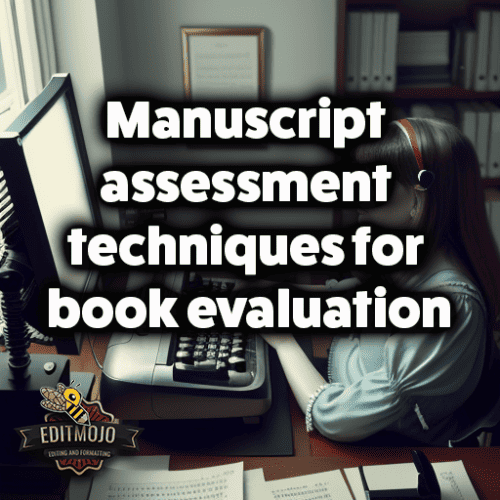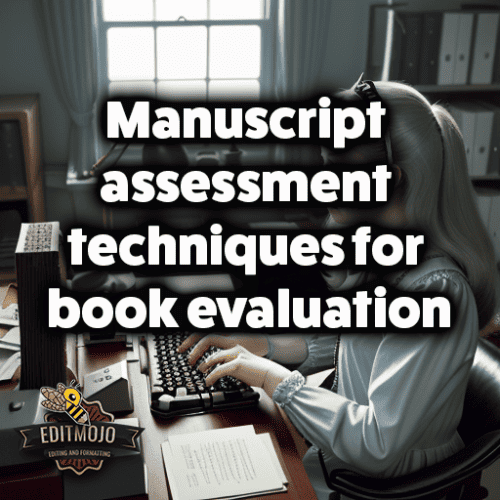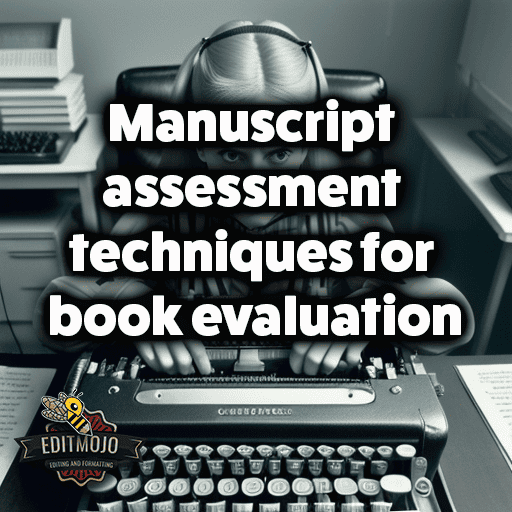Manuscript assessment techniques for book evaluation
Manuscript assessment techniques for book evaluation. As anyone who’s tried to create a compelling narrative knows, the craft of writing a book is a journey filled with excitement, creativity, and, of course, challenges. One pivotal stage in this journey is the manuscript assessment – a critical process that can potentially shape the destiny of your book. If you’re an author, an aspiring manuscript evaluator, or someone curious about how books are assessed, this article will guide you through the manuscript assessment techniques employed to evaluate a book. So, fasten your seatbelts, and let’s delve into the fascinating world of manuscript assessment!
Key Takeaways Table
| Topic | Key Takeaway |
|---|---|
| Understanding the Basics | Manuscript assessment is a crucial part of the book writing process, involving a thorough review of a manuscript to identify its strengths and weaknesses. |
| Core Techniques | These include plot and structure analysis, character evaluation, theme and message examination, writing style assessment, and presentation and format assessment. |
| Advanced Techniques | More in-depth evaluations can be made using comparative analysis, audience analysis, commercial evaluation, and multicultural evaluation. |
| Case Studies | Assessing a fictional or non-fictional manuscript requires considering several elements such as plot, characters, themes, writing style, audience appeal, and commercial potential. |
| Common Pitfalls | Evaluators must be careful to maintain objectivity, focus on the target audience, and keep up with market trends. |
| Constructive Feedback | Feedback should be constructive and diplomatic, highlighting areas of strength as well as areas for improvement. |
| Future of Manuscript Assessment | The future of manuscript assessment may involve AI and machine learning tools, but the balance between human intuition and AI analysis is crucial. |
Understanding the Basics
Manuscript assessment, often also referred to as a manuscript critique or manuscript evaluation, is a thorough review of a manuscript to identify strengths and areas for improvement. This assessment is done before the manuscript undergoes any significant editing processes.
The primary purpose of a manuscript assessment is to provide constructive feedback that can help authors revise their work. This feedback can be invaluable in ensuring the final product is well-structured, engaging, and commercially viable.
Moreover, an objective evaluation of a manuscript is essential. It allows authors and publishers to understand the manuscript’s potential and identify possible issues before investing significant resources in editing, production, and marketing.

Core Techniques in Manuscript Assessment
When evaluating a manuscript, several key factors need to be considered. Here are some of the core techniques used in manuscript assessment:
Plot and Structure Analysis
Assessing a manuscript’s plot involves more than just identifying the beginning, middle, and end. Evaluator needs to thoroughly analyze the narrative arc, looking for elements such as exposition, rising action, climax, falling action, and resolution. Any plot holes or inconsistencies should be flagged.
For instance, consider J.K. Rowling’s ‘Harry Potter’ series. The intricate plotting, the twists and turns, and the manner in which clues planted early on come to fruition later, all contribute to the series’ enchanting appeal.
Character Evaluation
Character evaluation forms a crucial part of the manuscript assessment. The evaluator should assess whether the characters are well developed, believable, and consistent. The characters should also undergo a clear arc or transformation by the end of the story.
Take the example of Elizabeth Bennet in Jane Austen’s ‘Pride and Prejudice’. Her journey from prejudice to understanding, and her character development throughout the novel, contribute significantly to the book’s enduring popularity.

Theme and Message Examination
Evaluators also examine the themes and messages presented in the manuscript. They need to assess how effectively these themes are integrated and developed throughout the story, and whether the message delivered is clear and impactful.
Consider Harper Lee’s ‘To Kill a Mockingbird’ – the themes of racism, moral education, and the loss of innocence are not only relevant but also woven seamlessly into the narrative.
Writing Style Assessment
The evaluator needs to assess the author’s voice and tone, and analyze their linguistic choices and techniques. This involves looking at elements such as the author’s use of dialogue, descriptions, point of view, and their overall ability to engage the reader.
For instance, Ernest Hemingway’s minimalist, ‘iceberg theory’ style of writing sets him apart and has had a significant impact on 20th-century fiction.
Presentation and Format Assessment
Lastly, the evaluator needs to assess the manuscript’s layout and format, including chapter length and structure, and paragraph breaks. They also need to consider the visual appeal and readability of the manuscript.
Advanced Techniques in Manuscript Assessment
While the core techniques form the basis of any manuscript assessment, several advanced techniques can provide a more in-depth and comprehensive evaluation.
Comparative Analysis
By comparing the manuscript with other successful works in the genre, evaluators can assess its potential for success. For example, a new detective novel might be compared to works by Agatha Christie or Arthur Conan Doyle to gauge its potential appeal.
Audience Analysis
Evaluators should consider whether the manuscript will resonate with its target demographic. A children’s book, for example, should not only be engaging but also appropriate for the age group it targets.
Commercial Evaluation
An essential aspect of manuscript assessment is considering its marketability and potential sales. Evaluators need to have a good understanding of market trends and reader preferences.

Multicultural Evaluation
In today’s globalized world, it’s crucial to assess the manuscript’s representation and cultural sensitivity. It should avoid harmful stereotypes and should respect cultural differences.
Case Studies: Successful Manuscript Assessment in Action
To better understand how manuscript assessment works, let’s consider a couple of case studies:
Case Study 1: Assessing a Fiction Manuscript
Let’s take Suzanne Collins’ ‘The Hunger Games’. In a manuscript assessment of this work, an evaluator would likely comment on the gripping plot, the strong character development of Katniss Everdeen, the engaging writing style, and the themes of survival and morality. However, the evaluator might suggest further enhancing the world-building elements or providing more depth to secondary characters.
Case Study 2: Assessing a Non-fiction Manuscript
For a non-fiction manuscript, like Yuval Noah Harari’s ‘Sapiens: A Brief History of Humankind’, an evaluator would assess the clarity and organization of information, the strength of the argument, and the author’s voice and style. The evaluator might suggest adding more anecdotes or personal stories to make the information more digestible for a broader audience.
Common Pitfalls in Manuscript Assessment and How to Avoid Them
While manuscript assessment is a crucial part of the book publishing process, it’s not without potential pitfalls. Here are some common ones and how to avoid them:
Subjectivity vs Objectivity
While personal taste can inevitably influence an evaluator’s opinion, they must strive to maintain an objective perspective. It’s essential to separate personal preference from a critique of the manuscript’s structure, style, and content.
Overlooking the Target Audience
An evaluator must always keep in mind the intended audience of the book. What might not work for a young adult novel could be perfectly acceptable in a book aimed at middle-grade readers.
Neglecting Market Trends
While it’s vital to respect an author’s artistic integrity, evaluators should also be mindful of market trends. Understanding what’s popular in the genre can help guide suggestions for the manuscript’s improvement.
Importance of Constructive Feedback and Professional Communication in Manuscript Assessment
Giving feedback in a constructive and diplomatic way is crucial. While it’s essential to highlight the areas for improvement, the evaluator should also commend the strengths of the manuscript. Maintaining a productive author-evaluator relationship is key to the successful revision of the manuscript.
The Future of Manuscript Assessment: Role of AI and Machine Learning
The advent of AI and machine learning holds great promise for the future of manuscript assessment. While AI tools are already being used to check grammar and readability, they could potentially help in more nuanced aspects of evaluation, like plot and character development. However, the balance between human intuition and AI analysis is crucial as both bring unique value to the process.
Conclusion (Manuscript assessment techniques for book evaluation)
Manuscript assessment is an art and a science. It involves a deep understanding of storytelling techniques, an appreciation for language, and an eye for detail. Whether you’re an author seeking to refine your work, a reader interested in how books are evaluated, or a budding manuscript evaluator, understanding these techniques can help you appreciate the intricacies of this fascinating process.
Remember, the road to a great book often involves rigorous manuscript assessment. So, let’s respect and appreciate this vital process in the journey of a book, from an author’s mind to a reader’s hand. Happy evaluating!
Top Five Questions and Answers Table (Manuscript assessment techniques for book evaluation)
| Question | Answer |
|---|---|
| What is a manuscript assessment? | It’s a thorough review of a manuscript to identify its strengths and weaknesses before it undergoes significant editing. |
| What are the core techniques used in manuscript assessment? | Core techniques include plot and structure analysis, character evaluation, theme and message examination, writing style assessment, and presentation and format assessment. |
| What are some advanced techniques used in manuscript assessment? | Advanced techniques include comparative analysis, audience analysis, commercial evaluation, and multicultural evaluation. |
| What are some common pitfalls in manuscript assessment? | Common pitfalls include being subjective rather than objective, overlooking the target audience, and neglecting market trends. |
| How can the future of manuscript assessment be shaped by AI and Machine Learning? | AI and machine learning can help in checking grammar, readability, and potentially even more nuanced aspects of evaluation like plot and character development. |
